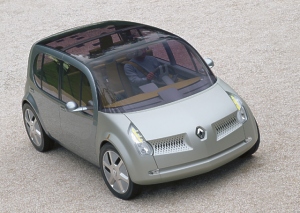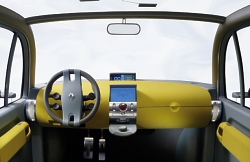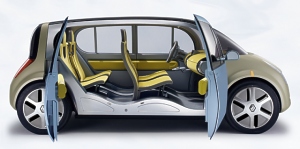
.
. .
..
. . .
Renault Concepts Renault Cars Related Topics
© 1998 - 2005 Copyright &
|
Renault : Ellypse Concept
The Ellypse concept car: "a bubble of optimism in the automotive world" Renault's latest concept car, Ellypse, heralds a new era of harmony between automobile and environment. Aggressiveness is banished from the smooth yet structured forms behind its friendly personality, while the deliberately minimalist interior radiates soothing vibes… proof that charm doesn't have to be contrived. A cleverly-designed car with new functions, Ellypse showcases the Touch Design concept for better man/machine interface. The Ellypse concept car also illustrates Renault's commitment to sustainable development through its environmentally friendly design: its architecture favours easy removal and recycling of components at the end of the car's life-cycle, the new-generation diesel engine reduces fuel consumption and exhaust emissions (85g of CO2/km), and it is equipped with advanced x-by-wire technology and 42-volt electrics. Ellypse is a 3.9-metre long hatchback with undeniable appeal. The shape of its headlamps and of the radiator grille, which incorporates the brand's new visual identity, give it a cheerful air. Its simple, non-aggressive contours, wrap-around windscreen and curved rear window make it hard to resist. Solar cells all along the transparent roof panel help optimize air-conditioning inside the cabin. Ellypse's soft and natural colour scheme mirrors its gentle forms, with Blue-tinted Almond for the front and rear, and Ultra Light Blue for the doors. While the left side is equipped with traditional doors, the right side reveals an original and innovative two-way opening system. Despite the absence of a centre pillar, the rear door opens either as a classic swing door to give direct access to the rear seats, or tilts from front to back. When the front door is also open, this second option completely frees access to the cabin. Intended as a simple, welcoming and friendly car, "Ellypse is a bubble of optimism in the automotive world," says Patrick le Quément, Senior Vice President, Corporate Design. A smart and simple interior
With its deliberately minimalist style and Mimosa decor, the cabin has a feel-good, soothing atmosphere. The long transparent roof combines with the vast glazed surface to let in light and give a wide-open vision of the outside. The shape of the dashboard leads onto the floor to create a gentle wave form that supports the four seats. A multi-function central control, built into the bottom of the dashboard and which can also be concealed, allows easy operation of most of the onboard features, including air-conditioning, radio, GPS navigation system with real-time traffic information, personal address book, maintenance manual and log book, and personalized servicing data. Confirmation of Renault's commitment to reinventing the cabin area, Ellypse's interior benefits from the Touch Design concept that first appeared on Talisman, thanks to which technology becomes simple and inviting for the user. Touch Design is built around a series of contrasts between simple shapes and technology "hubs" grouping the different functions. Often playful, the intuitive user-function interfaces make for efficient and pleasant operation. Like its predecessors, the Ellypse concept car is equipped with slim seats that maximize space inside the cabin. Comfort comes from soft and springy padded upholstery that stands up to intensive use and feels pleasant to the touch. Memory foam that adapts to passengers' body shapes adds to the sensation of comfort. Ellypse also introduces an innovative "ingenious seats" concept. Fully automated intelligent kinetics take the seat from a "road" position to a "rest" position. Occupants simply press a button in the front door panel to lie down and relax after a long drive. In just a few seconds the seat reclines into the floor, whose curved shape better moulds the body's contours. The ergonomic pillow supports the head in this recumbent position for complete comfort. An environmentally-friendly concept car Renault - a corporate citizen - has set out to make tomorrow's vehicles compatible with its commitment to sustainable development. Designed to respect the environment, this concept car heralds a new approach to vehicle design and development. The first objective is that components should be easier to disassemble and sort for recycling when the car reaches the end of its life-cycle. The designers thus focused their creativity on the need to simplify the vehicle design. The number of parts was deliberately limited: the bonnet, bumper and radiator grille are a single part, for example. Simple, clean-cut lines contribute to the overall purity of Ellypse's design. On a different level, attachments are rapidly loosened to make each element easier to remove. The materials used to make each part are clearly indicated to accelerate and optimize the sorting process. The same philosophy underpins cabin design, as upholstery can be rapidly removed from seats and dashboard. Again with an environmental focus, the vehicle's designers devoted time and energy to researching materials. Ellypse uses a majority of recycled, recyclable and renewable materials. The side doors are made from recycled aluminium. As well as being recyclable, aluminium reduces the car's weight which in turn cuts down fuel consumption. The structure is a combination of aluminium and steel, the latter also made from recycled metals. The bonnet, wings and rear are in polypropylene and are distinguished from the aluminium parts by a colour code. Polypropylene is made from recycled plastic car parts then coated with a recyclable tinted film. The floor is covered in "synderme", a natural and renewable material comprised mainly of leather offcuts. Soundproofing materials are lightweight and efficient. They are made mainly from vegetable fibres (mostly cotton) from recycled clothing, and polyester fibres from pre-sorted plastic bottles and packaging. Ellypse helps preserve air quality through its advanced-technology powertrain Ellypse is equipped with an innovative 16-valve 1200cc turbodiesel engine, developing 100bhp (72kW) and 200Nm torque. The advanced common-rail injection system uses specific piezoelectric injectors with 10 holes (instead of the usual four or five) for injection pressure of some 2,000 bar. Ellypse contributes to air quality by using a comprehensive and original emission control system. A four-way catalytic converter simultaneously processes carbon monoxide, nitrogen oxide, unburnt hydrocarbons and particulates. The onboard diagnostics system not only warns the driver when exhaust emission levels are exceeded, it also constantly analyses the physico-chemical composition of the emissions, fluids and gases inside the vehicle and will launch a maintenance alert when necessary. The turbodiesel internal combustion engine is assisted by a 12kW starter-alternator which has three different functions. It works as an alternator to produce electricity, in particular through the recovery of energy when braking, as a starter motor for the internal combustion engine, and as an electric traction motor whose output can be added to that of the internal combustion engine, and can even propel the vehicle alone over short distances. Transmission uses a robotized gearbox that optimally adjusts fuel consumption to driving style. The advanced technology of the powertrain combined with the car's low weight (980kg) result in excellent performance and emissions of just 85g of CO2/km measured over the new MVEG cycle (equivalent to around 3.2 litres/100km). Environmentally-minded electrics and electronics Specific electrics boost Ellypse's environmental rating. By supplying 42 volts rather than the usual 14, the starter-alternator is globally more efficient but also increases the number of electrically-powered functions. Electric air-conditioning, for example, contributes to optimal onboard energy management. By entering the x-by-wire era, Ellypse solves the problem of hydraulic circuits, which are less efficient than electrical systems, and of mechanical fluids that represent an environmental challenge both during (oil changes, leaks, etc.) and after (extraction) the vehicle's life-cycle. Hydraulic cylinders are replaced by electric actuators for the brakes, steering and robotized gearbox. The few remaining fluids (engine coolant and lubricants) are non-toxic and biodegradable. The designers have made it easier to recover these fluids at the end of the car's life-cycle by creating specific drainage points. Source : Renault
|
. |














